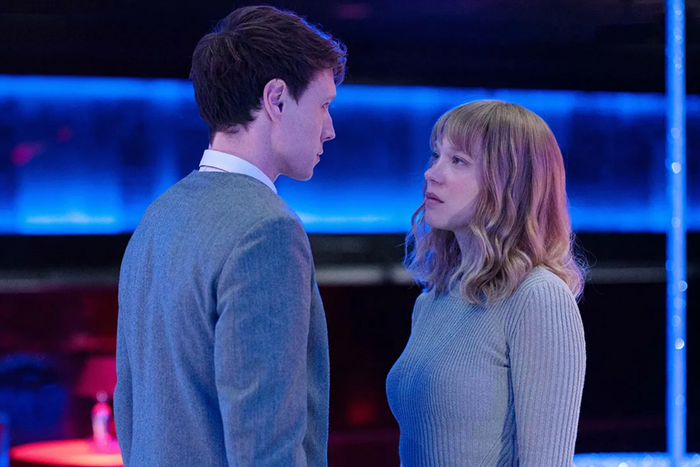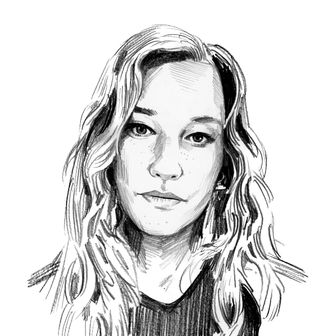
I’m writing this blog from jail, where my bail has been set at $5 million for writing the above headline, but this crime against language was worth it to write about Léa Seydoux in The Beast, her latest film that premiered at the Venice Film Festival this weekend. (Other options included “Don’t Mind If I Léa Seydoux” and “Léa Seydoux Can Say and Do Anything,” so be grateful.) Seydoux, who’s a European festival mainstay but skipped Venice this year out of SAG-strike solidarity, is always impressive — she can do indie French lesbian erotic romance just as easily as she can do Bond Girl; at Cannes in 2021, she was in four films at once, including a Wes Anderson movie where she played a stony cop and a French dramedy about a young TV journalist spiraling out of control. Last year’s Crimes of the Future saw her erotically performing surgery as performance art. In other words, she’s always had range, but never has that been more apparent than in The Beast, where her performance effortlessly glides across three different time periods, three different genres, two different languages, and at least four different wigs.
Directed by Bertrand Bonello, the film is a loose adaptation of Henry James’s novella The Beast in the Jungle, about an extremely anxious man who lets his life pass him by as he awaits a vague, horrible fate he’s foreseen for himself that never arrives. In Bonello’s film, that unfortunately relatable affliction is bestowed upon Seydoux’s Gabrielle, a woman whose life and star-crossed love story with Louis (George MacKay) we see unfolding across time, language, space, and genre: There’s a Merchant-Ivory-esque romantic drama taking place in the early 1900s Paris, a chilling horror film set in 2014 Los Angeles, and a melancholy sci-fi set two decades in the future.
In that 2044 segment, humanity has transcended emotion and conflict and artificial intelligence reigns. Bonello has referred to it as a “quasi-dystopia”; nobody is upset anymore, but everybody is bored to tears, and the robots have all the jobs. Gabrielle is desperate to find work, but the 67 percent unemployment rate means she has to choose between holding onto her feelings and traumas, or engaging in a “DNA purification” ritual that will allow her to shed the weight of the human condition and get a good job that would otherwise be taken by AI. The ritual in question involves getting into an Under the Skin–esque black-tar bath and revisiting her past lives so that she can work through her repressed emotions and let them go. She decides to give it a whirl, and soon realizes that in each of her past lives, she’s been drawn inexplicably to MacKay’s Louis, as well as plagued by a sense of impending doom.
We first meet Gabrielle in that 2014 segment, when she’s a struggling, lonely actress in Los Angeles, house-sitting for a douchebag who monitors her every visitor from afar. She’s trying to break into the industry, acting in bizarre cell-phone commercials and opposite green-screen “beasts” that she can’t see (extended metaphor alert). Seydoux is the most grounded in this section of the film, depressed and yearning desperately for human connection, and does some appropriately tragic but believable acting-like-she’s-doing-VFX-acting. In this time period, MacKay is an incel directly inspired by and often quoting Elliot Rodger, hell-bent on getting revenge on all women, but specifically Gabrielle, for his perceived rejection. Bonello, MacKay, and Seydoux create an atmosphere of cold, liquid tension, with this section of the film unfolding not unlike the Drew Barrymore scene in the original Scream — Louis stalks the glass house she’s staying in as Gabrielle unravels inside of it, interacting only with her laptop, the owner of the house, and, briefly, bitchy girls at a local nightclub. At one point, the director of the commercial asks Gabrielle, “Can you get scared by something that isn’t here?” She looks startled. “Yes,” she says. “I think so.”
In 1913, Gabrielle is at her anxiety-queen heights, constantly freaking out about the future tragedy that awaits her and also about whether or not Paris is going to flood, but certain for some reason that those things are separate. She’s married to the owner of a doll factory, but having an intense emotional affair with Louis, who, in this time period, is a sexy single Parisian who hits on her at parties. She tells him she’s “spent my life thinking of things too horrible to relate,” and he’s like, “Okay, hot.” They write each other tormented letters and he says he’ll protect her from the doom-scenario she endlessly anticipates. Seydoux really gets to show off her tortured, horny rom-dram heroine chops here, her wide eyes often brimming over with unspilled tears; in one scene, she imitates the expression of a doll for at least 15 seconds, her face going completely flat for so long that it starts to become terrifying. Though she’s the most social version of herself here, she still registers as alienated, with Bonello often choosing to shoot her close up as she wrestles with her unnameable fear and her unexpressed lust.
She’s trying and failing to get rid of all of those qualities in the dystopian future, where she spots Louis, in this time period a sort of cipher who does yoga and stares curiously at her, also debating whether or not to purify his DNA. They see one another at an evolved version of the 2014 nightclub, one with a fluid theme that shifts depending on Gabrielle’s moods — sometimes it’s a 1980s club, sometimes a 1960s, sometimes full, sometimes empty. She communes there with a living “poupee” named Kelly (played with perfect oddity by Saint Omer actress Guslagie Malanda), as well as a disappearing-then-reappearing The Shining–esque bartender who dispenses spooky advice. Now that she knows about her previous incarnations, she’s desperately trying to figure out why Louis keeps reappearing across her lives (as well as freaky pigeons, fortune tellers, Madame Butterfly, a moody song about evergreen love, and lifelike dolls, among other recurring motifs), and what she’s supposed to do about it. Her future-life is stagnant, cerebral, and bleak, but over the course of the ritualistic visits to her past, she comes to realize that the eventual ruin she’s always feared might just be fear itself and the paralysis it induces. Seydoux is the most expressive here, frightened and often devastated, but occasionally content, her face crumpling in pain and expanding in delight.
Bonello intended for the film to be a showcase for Seydoux’s flexible capacity — a quality that seemingly even confounds him. As he writes in the press notes, “I wanted The Beast to be both a film about a woman and about the actress who embodies her … I couldn’t think of any other actress capable of playing Gabrielle across three eras. Léa Seydoux has a timeless and modern side. It’s a rare thing … I’ve known her well and for a long time, but when the camera looks at her, it’s impossible to know what she’s thinking. She’s a mystery.”
More From the Venice Film Festival
- Agnieszka Holland’s Green Border Is an Urgent Warning
- Ava DuVernay’s Origin Devastates Its Audience
- If Glen Powell’s Not Already a Star, This Movie Will Make Him One


